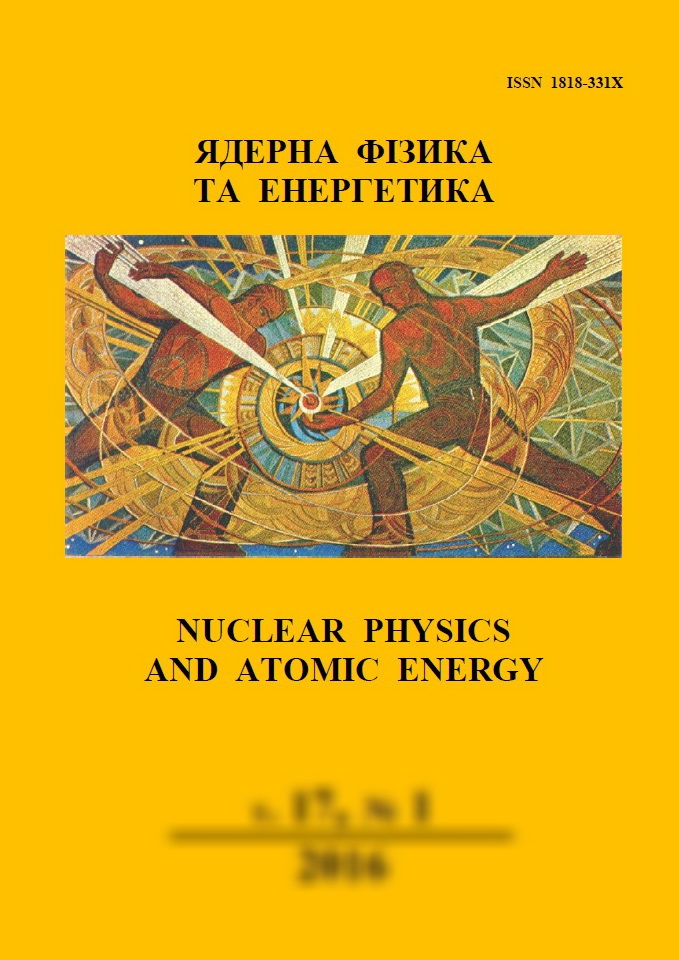 |
ядерна ф≥зика та енергетика
Nuclear Physics and Atomic Energy
ISSN:
1818-331X (Print), 2074-0565 (Online)
Publisher:
Institute for Nuclear Research of the National Academy of Sciences of Ukraine
Languages:
Ukrainian, English, Russian
Periodicity:
4 times per year
Open access peer reviewed journal
|
Nucl. Phys. At. Energy 2020, volume 21, issue 3, pages 249-255.
Section: Radiobiology and Radioecology.
Received: 17.01.2020; Accepted: 09.07.2020; Published online: 16.12.2020.
 Full text (en)
Full text (en)
https://doi.org/10.15407/jnpae2020.03.249
The titanium silicate influence on the Zn(II) and Sr(II) migration in the aquatic environment
Yu. M. Kylivnik1, V. V. Tryshyn2, M. V. Strilchuk2, O. V. Gaidar2, H. V. Vasylyeva3,*, S. I. Vuchkan3, O. Ya. Sych3, I. Yu. Syika3
1 Institute of Sorption and Endoecology Problems, Kyiv, Ukraine
2 Institute for Nuclear Research, National Academy of Sciences of Ukraine, Kyiv, Ukraine
3 Department of Theoretical Physics, Uzhgorod National University, Uzhgorod, Ukraine
*Corresponding author. E-mail address:
h.v.vasylyeva@hotmail.com
Abstract:
The aim of the present work is titanium silicate influence on the zinc and strontium migration in the aquatic environment. The adsorption capacity of titanium silicate toward zinc and strontium ions was investigated. With the aid of a fluorescent X-ray analyzer and energy dispersive spectroscopy the composition of the sorbent formed was determined as well as zinc and strontium presence on the surface of the sorbent after the sorption process. It was shown, that adsorption of zinc and strontium by titanium silicate strongly depends on time of interaction and solution acidity and increases with increasing of both parameters. It was established, that for the initial concentration of zinc and strontium at the level of 0.005M the presence of ions that cause the natural mineralization of water does not affect their adsorption extraction.
Keywords:
adsorption, strontium, zinc, titanium silicate, radionuclides migration, XRF-analysis.
References:
1. O.I. Symkanich et al. Distribution of heavy metals in the bottom sedimentations of the river Uzh in the territory of city Uzhgorod. Sci. Bull. Uzhgorod Univ. 1 (2015) 33.
2. V.V. Kanivets et al. 137Cs and 90Sr in the water of the ChNPP cooling pond. Yaderna Fizyka ta Energetyka (Nucl. Phys. At. Energy) 15(4) (2014) 370. (Ukr)
https://jnpae.kinr.kyiv.ua/15.4/Articles_PDF/jnpae-2014-15-0370-Kanivets.pdf
3. M.V. Zheltonozhska. Isotopes ratio investigation in soil samples from 5-km ChNPP zone. Yaderna Fizyka ta Energetyka (Nucl. Phys. At. Energy) 10(4) (2009) 409. (Rus)
https://jnpae.kinr.kyiv.ua/10.4/Articles_PDF/jnpae-2009-10-0409-Zheltonozhska.pdf
4. D.M. Bondarkov et al. Studies of radionuclides behavior on heavily contaminated 5-km zone of —hNPP. Yaderna Fizyka ta Energetyka (Nucl. Phys. At. Energy) 17(4) (2016) 381. (Rus)
https://doi.org/10.15407/jnpae2016.04.381
5. M.I. Panasyuk, I.A. Lytvyn. Regularities of uranium distribution in groundwater of ChNPP industrial site. Yaderna Fizyka ta Energetyka (Nucl. Phys. At. Energy) 18(1) (2017) 56. (Ukr)
https://doi.org/10.15407/jnpae2017.01.056
6. M.R. Abukhadra et al. Facile conversion of kaolinite into clay nanotubes (KNTs) of enhanced adsorption properties for toxic heavy metals (Zn2+, Cd2+, Pb2+, and Cr6+) from water. Journal of Hazardous Materials 374 (2019) 296.
https://doi.org/10.1016/j.jhazmat.2019.04.047
7. A.Yu. Lonin et al. Use of mathematical modeling for comparative evaluation of sorption capacity of natural and synthetic zeolites in relation to cesium. Yaderna Fizyka ta Energetyka (Nucl. Phys. At. Energy) 19(1) (2018) 63.
https://doi.org/10.15407/jnpae2018.01.063
8. I.F. Mironyuk, H.V. Vasylyeva. Sorption removal of Sr2+ and Y3+ ions from aqueous solutions by a TiO2 Ц based sorbent. RAD Conf. Proc. 3 (2018) 15.
https://doi.org/1021175/RadProc.2018.04
9. I.F. Myroniuk et al. The Kinetics of Adsorption Binding of Ba2+ ions by Trimethylsilylated Silica. Physics and Chemistry of Solid State 19(1) (2018) 66.
https://doi.org/10.15330/pcss.19.1.66-73
10. H. Vasylyeva et al. Adsorption of Barium and Zinc Ions by Mesoporous TiO2 with Chemosorbed Carbonate Groups. Physics and Chemistry of Solid State 20(3) (2019) 282.
http://doi.org/10.15330/pcss.20.3.282-290
11. J. Wang et al. Adsorption of aqueous neodymium, europium, gadolinium, terbium, and yttrium ions onto nZVI-montmorillonite: kinetics, thermodynamic mechanism, and the influence of coexisting ions. Environ. Sci. Pollut. Res. 25(33) (2018) 33521.
https://doi.org/10.1007/s11356-018-3296-0
12. J.M. Jacob et al. Biological approaches to tackle heavy metal pollution: A survey of literature. Journal of Environmental Management 217 (2018) 56.
https://doi.org/10.1016/j.jenvman.2018.03.077
13. I.F. Myroniuk et al. Neutron flux measurement of (γ, n)-reactions on nuclei of zirconium. RAD Conf. Proc. 2 (2017) 38.
https://doi.org/10.21175/RadProc.2017.09
14. I. Mironyuk et al. Effects of chemosorbed arsenate groups on the mesoporous titania morphology and enhanced adsorption properties towards Sr(II) cations. Journal of Molecular Liquids 282 (2019) 587.
https://doi.org/10.1016/j.molliq.2019.03.026
15. O. Oleksiienko et al. Pore structure and sorption characterization of titanosilicates obtained from concentrated precursors by the sol-gel method. RSC Advances 5 (2015) 72562.
https://doi.org/10.1039/C5RA06985H
16. I. Zhuravlev. Titanium Silicates Precipitated on the Rice Husk Biochar as Adsorbents for the Extraction of Cesium and Strontium Radioisotope Ions. Colloids Interfaces 3 (2019) 36.
http://www.doi.org/10.3390/colloids3010036
17. L.M. Horev. Hydrochemistry of Ukraine (Kyiv: Vyshcha Shkola, 1995) 307 p. (Ukr)
18. K.M. Mackay, R.A. Mackay, W. Henderson. Introduction to Modern Inorganic Chemistry. 5-th ed. (London: Blackie Academic & Professional, 1996) 467 p.
Google books
19. Atlas of Eh-pH diagrams. Intercomparison of thermodynamic databases. Geological Survey of Japan Open File Report No. 419.
https://www.nrc.gov/docs/ML1808/ML18089A638.pdf
20. http://www.calculator.net/standard-deviation-calculator.html
